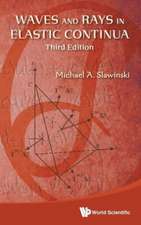Acoustical and Environmental Robustness in Automatic Speech Recognition: The Springer International Series in Engineering and Computer Science, cartea 201
Autor A. Aceroen Limba Engleză Hardback – 30 noi 1992
| Toate formatele și edițiile | Preț | Express |
|---|---|---|
| Paperback (1) | 940.57 lei 43-57 zile | |
| Springer Us – 13 iul 2013 | 940.57 lei 43-57 zile | |
| Hardback (1) | 946.55 lei 43-57 zile | |
| Springer Us – 30 noi 1992 | 946.55 lei 43-57 zile |
Din seria The Springer International Series in Engineering and Computer Science
- 24%
 Preț: 1041.97 lei
Preț: 1041.97 lei - 20%
 Preț: 643.50 lei
Preț: 643.50 lei - 18%
 Preț: 1225.62 lei
Preț: 1225.62 lei - 18%
 Preț: 965.02 lei
Preț: 965.02 lei - 20%
 Preț: 646.12 lei
Preț: 646.12 lei - 18%
 Preț: 948.79 lei
Preț: 948.79 lei - 20%
 Preț: 646.62 lei
Preț: 646.62 lei - 15%
 Preț: 637.46 lei
Preț: 637.46 lei - 20%
 Preț: 643.83 lei
Preț: 643.83 lei - 18%
 Preț: 949.23 lei
Preț: 949.23 lei - 20%
 Preț: 644.48 lei
Preț: 644.48 lei - 20%
 Preț: 994.92 lei
Preț: 994.92 lei - 20%
 Preț: 645.97 lei
Preț: 645.97 lei - 18%
 Preț: 946.87 lei
Preț: 946.87 lei - 20%
 Preț: 995.57 lei
Preț: 995.57 lei - 18%
 Preț: 956.99 lei
Preț: 956.99 lei - 20%
 Preț: 644.98 lei
Preț: 644.98 lei - 15%
 Preț: 649.54 lei
Preț: 649.54 lei - 18%
 Preț: 950.21 lei
Preț: 950.21 lei - 18%
 Preț: 1221.38 lei
Preț: 1221.38 lei - 18%
 Preț: 957.62 lei
Preț: 957.62 lei - 15%
 Preț: 643.99 lei
Preț: 643.99 lei - 18%
 Preț: 948.47 lei
Preț: 948.47 lei - 18%
 Preț: 947.35 lei
Preț: 947.35 lei - 20%
 Preț: 1284.65 lei
Preț: 1284.65 lei - 20%
 Preț: 1628.31 lei
Preț: 1628.31 lei - 20%
 Preț: 1285.78 lei
Preț: 1285.78 lei
Preț: 946.55 lei
Preț vechi: 1154.34 lei
-18% Nou
Puncte Express: 1420
Preț estimativ în valută:
181.12€ • 189.61$ • 149.87£
181.12€ • 189.61$ • 149.87£
Carte tipărită la comandă
Livrare economică 07-21 aprilie
Preluare comenzi: 021 569.72.76
Specificații
ISBN-13: 9780792392842
ISBN-10: 0792392841
Pagini: 186
Ilustrații: XXI, 186 p.
Dimensiuni: 155 x 235 x 13 mm
Greutate: 0.48 kg
Ediția:1993
Editura: Springer Us
Colecția Springer
Seria The Springer International Series in Engineering and Computer Science
Locul publicării:New York, NY, United States
ISBN-10: 0792392841
Pagini: 186
Ilustrații: XXI, 186 p.
Dimensiuni: 155 x 235 x 13 mm
Greutate: 0.48 kg
Ediția:1993
Editura: Springer Us
Colecția Springer
Seria The Springer International Series in Engineering and Computer Science
Locul publicării:New York, NY, United States
Public țintă
ResearchCuprins
List of Figures.- List of Tables.- Foreword.- Acknowledgments.- 1. Introduction.- 1.1. Acoustical Environmental Variability and its Consequences.- 1.2. Previous Research in Signal Processing for Robust Speech Recognition.- 1.3. Towards Environment-Independent Recognition.- 1.4. Monograph Outline.- 2. Experimental Procedure.- 2.1. An Overview of SPHINX.- 2.2. The Census Database.- 2.3. Objective Measurements.- 2.4. Baseline Recognition Accuracy.- 2.5. Other Databases.- 2.6. Summary.- 3. Frequency Domain Processing.- 3.1. Multi-Style Training.- 3.2. Channel Equalization.- 3.3. Noise Suppression by Spectral Subtraction.- 3.4. Experiments with Sphinx.- 3.5. Summary.- 4. The SDCN Algorithm.- 4.1. A Model of the Environment.- 4.2. Processing in the Frequency Domain: The MMSEN Algorithm.- 4.3. Processing in the Cepstral Domain: The SDCN Algorithm.- 4.4. Summary.- 5. The CDCN Algorithm.- 5.1. Introduction to the CDCN Algorithm.- 5.2. MMSE Estimator of the Cepstral Vector.- 5.3. ML Estimation of Noise and Spectral Tilt.- 5.4. Implementation Details.- 5.5. Summary of the CDCN Algorithm.- 5.6. Evaluation Results.- 5.7. Summary.- 6. Other Algorithms.- 6.1. The ISDCN Algorithm.- 6.2. The BSDCN Algorithm.- 6.3. The FCDCN Algorithm.- 6.4. Environmental Adaptation in Real Time.- 6.5. Summary.- 7. Frequency Normalization.- 7.1. The Use of Mel-scale Parameters.- 7.2. Improved Frequency Resolution.- 7.3. Variable Frequency Warping.- 7.4. Summary.- 8. Summary of Results.- 9. Conclusions.- 9.1. Contributions.- 9.2. Suggestions for Future Work.- Appendix I. Glossary.- Appendix II. Signal Processing in Sphinx.- Appendix III. The Bilinear Transform.- Appendix IV. Spectral Estimation Issues.- Appendix V. MMSE Estimation in the CDCN Algorithm.- Appendix VI. Maximum Likelihood via the EM Algorithm.- Appendix VII. ML Estimation of Noise and Spectral Tilt.- Appendix VIII. Vocabulary and Pronunciation Dictionary.- References.



















